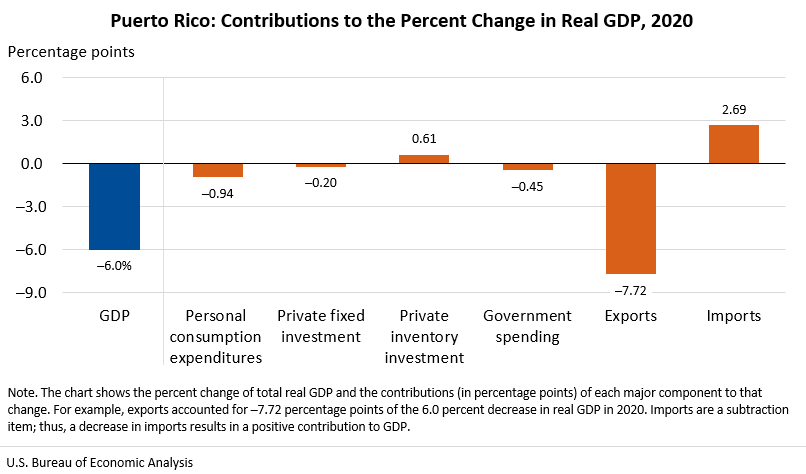Real gross domestic product for Puerto Rico decreased 6.0 percent in 2020 after increasing 0.2 percent in 2019, according to statistics released today by the U.S. Bureau of Economic Analysis.
The decrease in real GDP in 2020 primarily reflected a decrease in exports of goods and services. Personal consumption expenditures, government spending, and private fixed investment also decreased. These decreases were partly offset by an increase in private inventory investment. Imports of goods and services, which is a subtraction item in the calculation of GDP, declined.
The Puerto Rico economy was affected by the COVID–19 pandemic due to its effects on spending by consumers, visitors, businesses, and governments. However, the full effects of the pandemic cannot be quantified in the GDP statistics for Puerto Rico, because the impacts are generally embedded in source data and cannot be separately identified.
Exports decreased 10.9 percent. Exports of goods decreased 8.3 percent while exports of services decreased 22.7 percent.
- The leading contributor to the decrease in exports of goods was pharmaceuticals and organic chemicals. Medical and scientific equipment and appliances—which is embedded within consumer goods and within capital goods including parts—was also a leading contributor to the decrease in exports of goods.
- The leading contributor to the decrease in exports of services was travel services, which includes goods and services purchased by visitors. Exports of travel services decreased 51.3 percent, largely reflecting decreases in cruise and air visitors due to the COVID–19 pandemic. Data published by the Puerto Rico Institute of Statistics show the total number of inbound air passengers decreased 51.9 percent; cruise ship passengers reported by the Puerto Rico Ports Authority decreased 72.5 percent.
- Personal consumption expenditures decreased 1.8 percent, primarily reflecting a decline in services. Food services and accommodations, “other” services (which includes services such as transportation, recreation, and education), and health care decreased, as nonessential businesses throughout the territory were subject to mandatory reductions in operations due to the COVID–19 pandemic.
- Government spending decreased 3.2 percent. Spending decreased among all levels of government, reflecting pandemic-related reductions in operations and declines in disaster recovery activities associated with the 2017 hurricanes. Although central and municipal government spending in 2020 was supported by Coronavirus Relief Fund payments, prior-year spending was elevated due to expenditures funded by federal disaster grants.
- Private fixed investment decreased 1.6 percent, primarily reflecting a decline in structures investment. Within structures, residential structures investment decreased 14.4 percent, reaching the lowest level of any year shown in BEA’s estimates. Nonresidential structures investment decreased 5.2 percent but remained at elevated levels, reflecting ongoing projects to rebuild and improve telecommunications infrastructure and hotel and lodging establishments.
For more information, read the full release.
